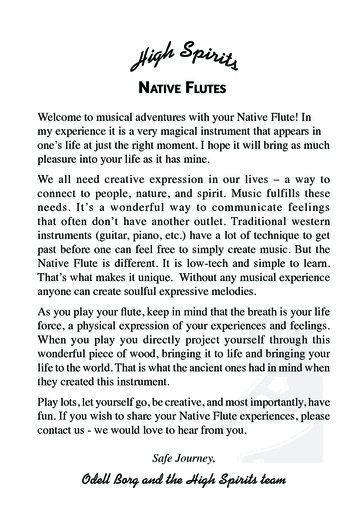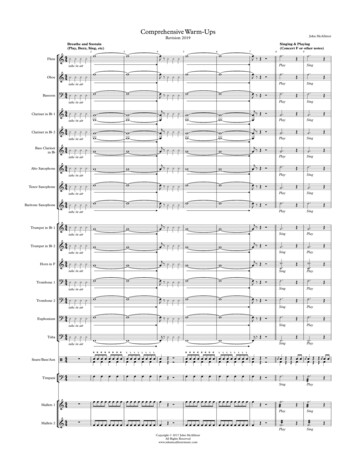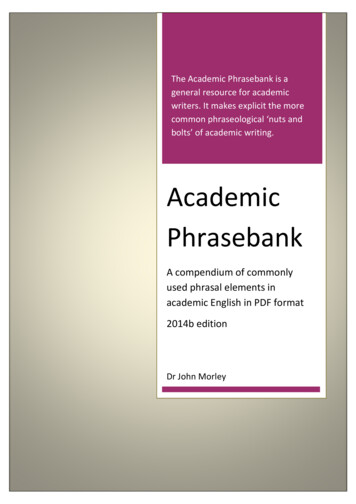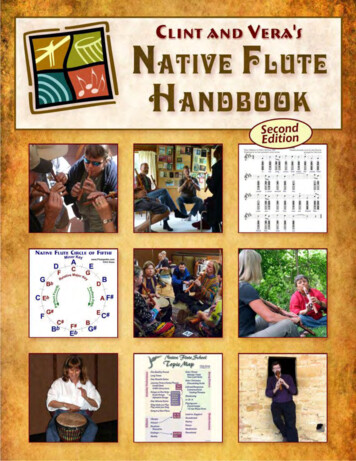
Transcription
Native FlutesWelcome to musical adventures with your Native Flute! Inmy experience it is a very magical instrument that appears inone’s life at just the right moment. I hope it will bring as muchpleasure into your life as it has mine.We all need creative expression in our lives – a way toconnect to people, nature, and spirit. Music fulfills theseneeds. It’s a wonderful way to communicate feelingsthat often don’t have another outlet. Traditional westerninstruments (guitar, piano, etc.) have a lot of technique to getpast before one can feel free to simply create music. But theNative Flute is different. It is low-tech and simple to learn.That’s what makes it unique. Without any musical experienceanyone can create soulful expressive melodies.As you play your flute, keep in mind that the breath is your lifeforce, a physical expression of your experiences and feelings.When you play you directly project yourself through thiswonderful piece of wood, bringing it to life and bringing yourlife to the world. That is what the ancient ones had in mind whenthey created this instrument.Play lots, let yourself go, be creative, and most importantly, havefun. If you wish to share your Native Flute experiences, pleasecontact us - we would love to hear from you.Safe Journey,Odell Borg and the High Spirits team
Fetish PlacementBefore you start playing, it is important that the fetish is positionedcorrectly so the flute achieves its optimal sound.Although the flute fetish is firmly tied down, it is not permanentlyglued so that it can be removed for cleaning and adjusted for the bestvoice. The photos below show the correct fetish position.Optimal position if your flutedoes not have a chamfer cut.Optimal position if your flutehas a chamfer cut.What is a Chamfer Cut?The chamfer is a 45º beveled cut along the edge of the sound hole.Traditional FlutesEvery flute has its own personality and w e employ differenttechniques to achieve each flute’s best voice. One such technique iscutting a chamfer on the sound hole as seen above. Some traditionalflutes will have this chamfer cut and some will not.Signature FlutesThe chamfer cut is an integral part of the mechanics o f signatureflutes. Therefore, all signature flutes will have a chamfer cut on thesound hole.High Spirits FlutesPO Box 522 Patagonia, AZ USA 85624(800) 394-1523 www.highspirits.com 2014 All Rights Reserved V.3
CONTENTSImportant Information - Please Read. iIntroduction. 1Kokopelli. 2How to Play. 2Important Tips . 4Creating Songs. 55-Hole and 6-Hole Flutes. 6Techniques. 6Moisture Buildup. 9Larger and Longer Flutes . 10Double and Triple Flutes. 10Care of the Flute . 11What if? -------- Solutions. 12Songs. 13Fingering Charts. 135-Hole Flute Fingering for Pentatonic Minor Scales . 146-Hole Flute Fingering for Pentatonic Minor Scales . 15“A”, “Bb”, “B”, “C”, “D”, “E”, “F#”, and “G”Chromatic Scales for 5 and 6-Hole Flutes . 16-23Playing Scales . 24Additional Scales . 25
IMPORTANT - PLEASE READLeather Tie in the Center of the FluteIf your flute looks like a 5-hole flute and has a piece of leather wrappedaround the center of it, it’s actually a 6-hole flute with the leathercovering one of the holes. The differences between 5 and 6-hole flutesare covered further in the “5-Hole and 6-Hole Flutes” section of thisbooklet (see page 6). For now you can leave the tie on and continue toplay it as a 5-hole flute or, if comfortable, simply remove the leatherto play a 6-hole flute. This makes a flute very versatile and eliminatesany confusion over which flute is best for you.GuaranteeWe stand behind our instruments completely. If the sound is affectedby any structural defect because of checking or natural cracks, wewill replace the flute within the first 30 days and repair the instrumentthereafter. In case of accidental damage beyond these conditions, wewill make every effort to repair it at a reasonable rate (plus shipping).We rarely see issues but we want you to understand the nature of wood.As we blow into a flute moisture from our breath will cause the wood toexpand and contract and natural check lines can occur. These lines looklike splits or cracks but rarely go all the way through the flute. To helpprevent check lines from forming we seal and treat every instrumentwith hardening oils.In the rare event that a check line does occur on your flute werecommend that you get in touch with us so we can help you.It is important to note that no matter what changes a wooden flute maygo through, if it retains its voice, it is an indicator that the structuralintegrity is solid.i
IntroductionFlutes are one of the most ancient instruments and are found throughoutthe world. For generations upon generations they have been closely tiedto our traditions, rituals and celebrations. That is why so many of usare hypnotically drawn to the haunting melodies they produce - theiressence runs deep in our veins.The origin of the Native American flute lies within the cultures of theancient people, those that came before the tribes and nations we arefamiliar with today. Their legacy produced a variety of flutes, each ofwhich is associated with different nations and tribes. We believe thatthe flute you have chosen is one of the most fascinating and technicallymarvelous instruments to emerge from this history. Its ingenious designproduces a sound that far surpasses its simplicity.The Native Americans, like most tribal cultures, did not have a writtenmusic language. They did not find it necessary. Their songs andplaying techniques were passed down from generation to generationin disciplined rituals and practice. Individual styles were developedby experimentation and imitation of sounds heard in nature. Since theydid not have sheet music and notes to follow, the music they createdcame spontaneously “from the heart”. This improvisational style isideal for unstructured self-expression, yet the Native Flute also easilyadapts to the structure of modern written music.Each of us is linked to a past in which nature was the dominant forceof life and music expressed our individual and collective experiences.Creating music deepened our connection with community and thenatural world around us. For many of us that connection is now weakand at some level we all feel its loss. Today, few things inspire thosefeelings of connection as strongly as music does.Much of what you will learn about this instrument comes from withinyou. Music flows through all of us. Listen thoughtfully, be patientwith yourself, and, most importantly, have fun!1
KokopelliKokopelli, the flute playing wanderer, was a gentle, minor god to thepre-Columbian Indians of the western United States. The Kokopellifigure has been found in the ruins of the Pit House People dating backas early as 200 A.D. and as late as the 16th century where it appearsin association with drawings of men on horseback, armored men, andmen in cowls. Kokopelli has many modalities: he is a personality, anindividual, the personification of a legend, a beneficent god to some anda confounded nuisance to others.Kokopelli was responsible for fulfilling many needs for his people,including rain, abundant food, music, merriment and dance. Kokopelli’slikeness varies almost as much as the legends about him, but on thewhole, he is unmistakable - dancing and always playing some type offlute.How to PlayThe most challenging aspect of playing this flute is to close all of theholes completely. If you can do that you can learn to play this instrument.Use your little fingers and thumbs to stabilize the flute and the pads ofyour other fingers (not the tips) to completely cover the holes (the largersurface area of the pads makes this easier). With all the holes closed,blow lightly into the flute. If the sound is weak blow a little harder.The sound you are listening for is a solid, deep, even tone that is pleasantto the ear. If you get anything else, it’s because one of the holes is stillslightly open or you are blowing too hard or possibly too softly. Justthe slightest opening left by one of your fingers will result in a buzzyor off-sounding note.If the bottom note sounds too high in pitch it’s likely that one ofthe upper two finger holes is slightly open. Adjust your fingers,making sure you are using the pads of your fingers, and try againuntil you achieve a deep bottom note with all the holes closed.A helpful tip here is to adjust your fingers instead of adding more fingerpressure - too much pressure will only cramp your fingers. Hold off onplaying the other fingerings until you achieve that bottom note becauseonce you can play that note the others are a breeze.2
Once you’re comfortable playing the low note the next skill is to play upand down the scale. For those who have never played a wind instrument,we recommend that you do this in front of a mirror. Lift one finger ata time from the bottom up until all the holes are open and then closeone finger at a time from the top down.Please, do this slowly! Pause at each note to listen to its sound. If itsounds solid, go on to the next note. If not, lift your finger and replaceit correctly (pad of the finger covering the hole completely). This willinstill good muscle memory. After successfully playing the scale acouple of times, try doing it with your eyes closed. This forces you todevelop your tactile skills. Another advantage to playing with your eyesclosed is that the notes will envelop you, creating a deeper understandingof how they interact.3
Important TipsClose the Holes CompletelyAny hole that is closed must be completely covered or you will get asqueaky sound. You will know it when you hear it.Play SlowlyTake your time with each note. It will help you develop good habits.Your fingering speed will come by itself.Close Your EyesThis develops your tactile skills and your muscle memory, helpingcoordination develop more quickly.BreatheBreathe at normal intervals; do not wait until you gasp for air. Yourbreath capacity will develop naturally.ExperimentTo learn the tonal range of each note, first, blow softly and then increaseyour breath until the note breaks.ToneEach note has a sweet spot. If a note is shrill or breathy, decreasethe air flow. If it is wispy or weak increase the air flow to liven it up.Finding the sweet spot on the bottom note (all holes covered) can bechallenging. It’s more delicate than the other notes and if you blowtoo hard it will go to the next octave, producing a high-pitched sound.Play the ScalePlay the scale from the bottom up and then go back down. Slightlyincrease the air flow as you play up the scale and decrease it on yourway back down.4
Creating SongsThe Native Americans, like many tribal cultures, never had a writtenmusic language; they did not find it necessary. In turn they developedinstruments that were naturally expressive and easy to play. The flutewas one of the more complex instruments they developed. It is set upin such a way that the notes are in harmony with each other. In westernmusic it is called the pentatonic scale. Penta, meaning five, representsthe five notes on the flute. For those of you that have a 6-hole flute, besure to read the section on “5-hole and 6-hole flutes”. Because all notescomplement each other this flute is very easy to play and you cannot gotoo far wrong as you start to play and experiment.By now you have been playing the scale up and down and aremore than likely comfortable with it. That’s great! This meansyou’ve established the correct finger technique and muscle memory.Now it’s time to add some variation. Continue to play up and down thescale, but this time hold some notes longer and some shorter. Try repeatingsome notes, going back and forth between two or three. When you pause totake a breath, change your fingering so you restart on a different note thanyou finished on. Listen to the way the notes interact and to the rhythmsyou create; when you hear a combination you like repeat it a few times.These improvisational techniques will develop your understanding ofhow different notes interact to create melodies and the more feeling youput into it, the richer your melodies will be. Remember, the importantthing is that it sounds good to you; this is for your own pleasure andentertainment. No pressure - just fun!When you first begin creating music on your flute try to let go of anystructured ideas you may have. It’s not necessary to know any music theoryor to read music to create songs on this flute. If you feel you need morestructure try using the verse-chorus form. In this form, you play something,repeat it once or twice, play something different, and then go back andplay the first part again. No matter what method you use, keep it simple.Beautiful songs don’t need to be complex and before you know it yourstyle will develop and diverse melodies will flow naturally.5
Remember, there is no right or wrong way to create music. If it’s pleasingto you that’s all that matters. Be creative, have fun, and play and practicewhen you feel like it. Playing your flute is not a chore that must be done;it’s a joy to be celebrated!5-Hole and 6-Hole FlutesIt is important to note that none of the information in this section isnecessary to play the flute. It only becomes necessary if you want toplay other scales or plan to play written music.All Native American flutes are based on the five note pentatonic scale(“penta” meaning five). These five notes are harmonic to each other.That is why 5-hole flutes are so easy to play and require no musicalbackground. However, other scales can also be played on the NativeFlute. For example, both the diatonic and chromatic scales can be playedon the Native Flute.We mentioned earlier that the Native Flute has five basic notes whichcreate the pentatonic scale. When the sixth hole is introduced it alsoallows other scales to be more easily played by making the fingeringsfor these other scales less complex. However, playing the sixth holecan create a dissonant sound if it’s not used properly. This is whywe recommend that beginning players start with the basic five notepentatonic scale. After playing for a while your ear will become moredeveloped and through experimentation this extra note can be includedmore easily.TechniquesWhen you are trying new techniques on the flute, stick to using thetop two or three notes. The two bottom notes tend to be more delicate,making initial experimentation challenging. Once you feel comfortablewith the way they play/sound on the top notes, apply your newtechniques on the bottom notes too.EmbouchureThe mouth position used to play an instrument is called an embouchure.When first playing a Native Flute, the natural tendency is to place the6
whole mouth end of the flute into one’s mouth and blow. This techniquehas a few downfalls: it creates excess moisture in the flute, hindersbreath and tonguing techniques, and reduces the ability to control theairflow.Instead, close your lips then place the flute against them, much likeyou are kissing it. Another technique is to allow your upper lip toclose about half of the air hole and place the lower lip just slightlyunderneath the air hole.In this way the airpassage from the mouth isreduced and backpressureis created. This techniqueprovides a better sound,less moisture buildup,and more control of theflute.BreathIn the beginning playing the flute is all about fingering. Those techniqueswill solidify fairly quickly. Once you feel comfortable with yourfingering, the flute becomes all about your breath. Think of it likesinging with your breath. When we sing we try to be melodic by usinginflections in our voice, otherwise we sound monotone. The same holdstrue when playing the flute. If you just blow a continuous stream ofair, it’s somewhat monotonous, but if you vary your breath pressure tocreate inflections it brings color and feeling to the notes.Without the flute in your mouth, try creating a short melody with yourbreath by varying breath pressure (like whistling without sound). Now,using just a couple of notes, do the same thing into the flute. Applyingthis technique while playing the scale or any simple melody will bringyour playing to life.Any way that you devise to change the airflow from your mouthwill change the sound on the flute. Try moving your tongue rapidly7
in front of the mouthpiece, or try trilling or snapping your tongue.Altering the airflow in any way will produce unique effects.We all have different abilities and styles, so be creative.TonguingTonguing is a technique used to create rhythm by stopping andstarting the air flow to the flute. To perform this technique, thetongue quickly touches the roof of the mouth just behind thefront teeth, like making the sound “ta”. Without the flute say“ta”. Notice where your tongue touches the roof of your mouth.Now say, “ta, ta, ta, ta”, now “ta, ,ta, ,ta, ,ta,ta,ta,ta, ,ta, ,ta.”Repeating the second or third line over and over creates a rhythm. Onyour flute, try this on a single note first, and then try changing notes atthe point when the breath stops (at each “ta”). Tonguing can be very fastand deliberate or slow and subtle as well as all ranges in between. Usingdifferent tonguing styles will bring feeling and life to your melodies.FingeringFingering affects the sound of the flute as well. Slipping your fingerslowly off a hole will change the note with a sliding effect. Rolling afinger partly off a hole and then re-covering it will produce a moody orblues quality. Covering a hole only half way produces a different note.Experiment and develop your own unique style and techniques.Jumping NotesUp to this point the melodies you have been playing are composed bymoving from one note to the note just above or below it. Now it’s timeto jump notes. Jumping notes allows you to jump from one note to anyother note within a scale.To do this you’ll need to follow one simple rule: when you open or closeany hole on your flute, all the holes below that hole have to be open andall the holes above it need to be closed. The only exception to this ruleis that the third finger hole down from the mouthpiece must stay closedat all times (this applies to 6-hole flutes only).When following this rule, any note you play will be harmonious withthe next one. A good way to see this rule visually is with the following8
fingering chart. This chart shows the fingering pattern of each note inthe basic 5 note pentatonic scale. Notice that each note follows this rule,everything above is closed, everything below is open (third hole fromthe mouthpiece is always closed).- Closed- OpenMouthpieceExperimenting with different fingering and breath techniques is funand rewarding. If you feel you are getting bored with your playingor feel like you have reached a plateau, take it as a positive signthat you have mastered your present techniques. At this point it’stime to get experimental. Put what you know aside, make strangesounds, move your fingers turtle slow or rabbit fast, mimic birdsongs or the wind in the trees. These types of experimentationwill enhance your style and push you beyond your plateau.We have had the pleasure of playing flute with many people and arealways amazed that no two sound the same; everyone has his or herown individual style.Moisture Buildup in the FluteWhen blowing into the flute, condensation from the breath willbuild up in the air chamber and, over time, will clog the air passageso that the air will not be able to flow easily. Until the tongue andmouth become used to the mouthpiece moisture buildup can befrequent. The buildup normally occurs after playing for a while.One solution is to place a finger partially over the sound hole(see fig.1, page 11) and blow hard into the flute. The moisture willcome out from the front of the fetish as a drop or spray of water.Then hold the flute by the bottom end (opposite of mouthpiece)9
and shake the moisture out of the breath chamber. Another optionis to take the fetish off, let it dry out, and then tie it back on (seepage 12). Creating an embouchure when playing the flute will alsohelp in reducing the moisture buildup (see Embouchure sectionpage 6). Additional information about embouchures can be found atwww.highspirits.com.Larger and Longer FlutesMost of us start off with a shorter flute because they are easier to play,are a smaller investment, and we want to see if we connect with theinstrument. But everyone loves the sound of the deeper tones. If youdecide to purchase or have purchased a deeper toned Native Flute,then you will be playing a larger instrument. On larger flutes the breathcontrol and style of play is more subtle and sensitive, so going froma smaller to larger flute can take some adjustment. However, this iseasily compensated for by the mellow, warm, expressive feel that thedeeper tones create. For more information on playing larger flutesgo to www.highspirits.com.Double and Triple FlutesThere are two types of double flutes being made - double barrel shotgunstyle and split “V” style. We make the “V” style double flute with twoseparate breath holes; one for the melody flute and one for the droneflute. This allows the flute to instantly be played as a single or doubleflute, adding versatility and richness to your melodies. Double flutesdo take a different style of play and we suggest experimenting to createyour own unique sound. Here are a few tips: Depending on what part of the flute you wish to emphasize(melody side or drone side), move the flute slightly in thatdirection so that side receives more air.When playing both sides try tonguing the higher notes (seesection on Techniques) and adding a bit more breath pressure.This will drive the drone to the high octave.It does take a bit more air to play these flutes. Using an embouchurewill help in regulating the airflow (see Embouchure section - page 6).10
Functional Parts of the Flutefig.1The triple flute is unique in that it has two drones and a melody flute.One drone plays “A” minor while the other drone has three holes thatcan be opened or closed to create different drone notes. The centerflute has six holes on which the melody is played. Triple flutes arewonderful performance instruments, but we only recommend themfor experienced players.Care of the FluteAfter we make the flutes we treat them with several coats of nontoxic oilthat hardens the wood. This does not have to be done again unless theinstrument is heavily used. If the flute starts to lose its luster we recommendthat a nontoxic oil be used to bring back the finish. There are commercialproducts available such as wooden salad bowl oils or any other refined,food grade oil that you like the taste of. At the time of oiling apply a coatof oil inside the bore. After letting the oil sit for ten minutes or so, wipeoff the outside of the flute but let the oil inside the bore soak in (do notwipe it off).To get the best possible sound from the flute it is important that the fetish(piece tied on top of the flute) be tied down tight. Leather has a tendencyto stretch so the fetish has to be re-tied periodically. We secure the fetishwith a rubber band first and then wrap the leather around it. After tyingthe fetish down tight, you will still be able to adjust it.The ideal position for the fetish is just in back of and centered on thesound hole (see fig. 1, page 11 and image 4 page 12). The sound hole11
should not be covered by any part of the fetish. The fetish can be movedback and forth to get a slight difference in pitch but we have found that thesweet spot is in the position described above.How to Remove and Replace the Fetish:121. Undo the square knot.2. Unwrap leather.343. Remove rubber band and fetish.4. Correct fetish position.What if? . solutions!Cannot get any sound:a) Make sure the fetish is in the proper position and tied down tightly(see fig.1, page 11) .b) Check that the fetish is not covering any part of the soundhole and that the fetish is centered behind the sound hole(see fig.1, page 11).The sound is weak or buzzy:a) If it has been played a lot, check for moisture buildup.b) Check to see if the fetish is in the proper place and is tied down tightly(see fig.1, page 11) .The low (bottom) note breaks to a high note or is squeaky:a) Make sure that all the fingering holes are completely closed. Playflat-fingered using more of the fleshy pads of your fingers.b) Use less air pressure when you play the note. If you blow too hardon that bottom note it will break to the next octave.12
The flute sounds off-key or makes unpleasant sounds:a) Make sure all of the fingering holes are completely closed.Play flat-fingered using more of the fleshy part of your fingers.b) Increase or decrease the breath to make the note sharper or flatter,respectively.For additional information be sure to visit our FAQ page atwww.highspirits.com.SongsThe tribal cultures that created these types of instruments did not havewritten music. The basics were handed down and the rest came from theheart. We honor that. This beautiful instrument is an improvisationalgift through which we have the ability to express our heart’s song. Weencourage you to experiment by creating your own songs and expressions.You will find the process very liberating, easy, and rewarding.That said, songbooks can be a fun and motivating way to learnand play the Native Flute. If you are interested in learningsongs we have a variety of songbooks available on our websitewww.highspirits.com.Fingering ChartsThe following pages contain fingering charts for 5 and 6-hole flutes inthe minor keys of “A”, “Bb”, “B”, “C”, “D”, “E”, “F#” and “G”. Onthe charts, the black dots indicate closed holes and the tapered end of thedrawing indicates the mouthpiece. Under each fingering diagram is thecorresponding note.Please remember that with all wind instruments the amount of air pressureexerted will determine the accuracy of the note. More pressure will sharpenthe note, while less pressure will flatten it.We provide fingering charts because many people are interested in theinformation they provide but you don’t need them to enjoy playing musicon the Native Flute. In many cultures people never learn music theory.They create beautiful melodies simply “playing by ear”.13
5-Hole Flute Fingering forPentatonic Minor ScalesKey of “A”ACDEGAKey of “Bb”(“A#”) BbC#D#FG#BbKey of “B”BDEF#ABKey of “C”CD#FGA#CKey of “D”DFGACDKey of “E”EGABDEKey of “F#”F#ABC#EF#Key of “G”GA#CDFG14
6-Hole Flute Fingering forPentatonic Minor ScalesKey of “A”ACDEGAKey of “Bb”(“A#”) BbC#D#FG#BbKey of “B”BDEF#ABKey of “C”CD#FGA#CKey of “D”DFGACDKey of “E”EGABDEKey of “F#”F#ABC#EF#Key of “G”GA#CDFG15
Scales for different octaves may vary and can be found online atwww.highspirits.com/alternate-octave-scales16BC C# D D# E FABC C# D D# E F“A” chromatic scale for 6-hole fluteA“A”chromatic scale for 5-hole fluteF# G G# A A# B CF# G G# A A# B C
Scales for different octaves may vary and can be found online atwww.highspirits.com/alternate-octave-scales17D# EF F# GG # A B b(A#)B CB b(A#)C C # DD# EF F# GG # A B b(A#)B C“Bb” (“A#”) chromatic scale for 6-hole fluteB b(A#)C C # D“Bb” (“A#”) chromatic scale for 5-hole fluteC#C#
Scales for different octaves may vary and can be found online atwww.highspirits.com/alternate-octave-scales18C# DD# EFF# G G# ABC# DD# EFF# G G# A“B” chromatic scale for 6-hole fluteB“B” chromatic scale for 5-hole fluteA# BA# BC C# DC C# D
Scales for different octaves may vary and can be found online atwww.highspirits.com/alternate-octave-scales19D D# EFF# G G# A A# BCD D# EFF# G G# A A# B“C” chromatic scale for 6-hole fluteC“C” chromatic scale for 5-hole fluteCCC# D D#C# D D#
Scales for different octaves may vary and can be found online atwww.highspirits.com/alternate-octave-scales20EF F# GG# A A# B CDEF F# GG# A A# B C“D” chromatic scale for 6-hole fluteD“D”chromatic scale for 5-hole fluteC# D D# EC# D D# EFF
Scales for different octaves may vary and can be found online atwww.highspirits.com/alternate-octave-scales21F# GG# AA# B CEF# GG# AA# B C“E” chromatic scale for 6-hole fluteE“E”chromatic scale for 5-hole fluteC# D D# EC# D D# EF F# GF F# G
Scales for different octaves may vary and can be found online atwww.highspirits.com/alternate-octave-scales22A# BCC# DF# G# AA# BCC# D“F#” chromatic scale for 6-hole fluteF# G# A“F#” chromatic scale for 5-hole fluteD# ED# EFFF# G G# AF# G G# A
Scales for different octaves may vary and can be found online atwww.highspirits.com/alternate-octave-scales23A A# BCC# D D# EGA A# BCC# D D# E“G” chromatic scale for 6-hole fluteG“G” chromatic scale for 5-hole fluteFFF# G G# AF# G G# AA#A#
Playing ScalesThe term “Scales” describes a sequence of notes that musically relate toeach other. There are thousands of different scales found throughout theworld and each has its own personality and feel.You have already experienced playing one scale. By simply playingup and down the flute with the third fingering hole from the top closed(when
play it as a 5-hole flute or, if comfortable, simply remove the leather to play a 6-hole flute. This makes a flute very versatile and eliminates any confusion over which flute is best for you. Guarantee We stand behind our instruments completely. If the sound is affected by any st










